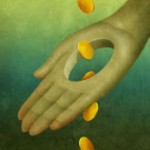Credit Crisis Only Begins With Mortgages
One can pity Federal Reserve Chairman Ben S. Bernanke. No other federal reserve chairman ever cut interest rates by a full 1.25% within just eight days, as
Jul 31, 2020105K Shares1.4M Views
Image has not been found. URL: /wp-content/uploads/2008/09/bernanke4.jpgFederal Reserve Chairman Ben Bernanke (WDCPix)
One can pity Federal Reserve Chairman Ben S. Bernanke. No other federal reserve chairman ever cut interest rates by a full 1.25% within just eight days, as Bernanke has done. But the monetary skies remain as leaden and thunder-clouded as ever. The stock market keeps quivering downward, crowds thin at the malls, jobless queues grow. Wal-Mart reports that customers are using their Christmas gift cards for groceries.
Illustration by: Matt Mahurin
The hard reality is that the economy is facing a one-two knockout blow from a collapse in consumer spending, plus a shock-and-awe wave of asset write-downs that is wreaking havoc in the financial sector. The more Bernanke floods the economy with easy money, the worse the final reckoning is likely to be.
First the consumer. For decades, personal consumption’s share of GDP averaged in the 66 percent-67 percent range. In 2000, however, it moved up sharply, hitting 72 percent in early 2007, the highest rate of consumption in any modern country ever.
How did consumers pay for it? Well, not with their wage packet — median household incomes were roughly flat in the 2000s. Instead, households doubled their debt load, and personal savings rates dropped to zero.
Almost all the new borrowing was against houses. Very low interest rates and super-easy mortgage rules drove house prices up 50 percent between 2000 and 2005, one of the fastest jumps in history. As prices soared, consumers refinanced again and again, rolling over the proceeds into pricier houses and more consumption. Wall Street’s economists looked on happily, and constructed elaborate theories proving that the debt spiral could continue indefinitely.
But as outstanding mortgages balances ratcheted higher and higher, they finally smacked up against the ability of homeowners to service their debt, no matter how low the interest. A tipping point was crossed last year, when it dawned on markets that houses were overpriced – and by a whole lot. Home prices are now in free fall; price drops of 20 percent to 30 percent will be required to get them back in line with incomes. Stuck with heavy debt service and no cash left in their homes, consumers are cutting back hard. The credit merry-go-round, in short, has started to run backwards.
The truly bad news is that the credit crisis is not just about home mortgages. The same problems infect almost every important asset class. Commercial mortgages had a drunken spree of their own in 2006 and 2007. A sign of the times: the big New York developer, Harry Macklowe, is unable to pay $7 billion in debt on seven prime Manhattan office buildings he bought less than a year ago. The takeover loans that fueled the 2006-2007 stock market boom are also faltering badly. Trading markets are now pricing prime takeover loans and commercial mortgages as if they were junk bonds.
On quite reasonable assumptions, total market losses from defaults and writedowns on mortgages of all kinds, and from junk bonds, leveraged takeover loans, credit cards, and auto loans, will be in the range of $1 trillion.
(What are “writedowns?” Suppose I pay $1000 for an apparently high-quality 10-year bond that pays 5 percent, or $50, a year. Then, suppose my bond turns out to be riskier than I thought – say, the kind that usually pays 9 percent returns. How much can I sell it for? The answer is about $720; at that price, the $50 in interest equates to a 9 percent yield on the investment. The $1000 bond, that is, has lost 28 percent of its value. If it is held in a bank trading account, the bank would have to reduce its stated profits and equity capital by that amount.)
Roughly half the shaky mortgages and other loans are on the books of banks, with the rest spread among hedge funds, pension funds and individual investors. Banks have already written off $130 billion of bad loans, so they have some $250-$350 billion to go. Reductions in equity capital have about a 10-to-one downward ratchet effect on a bank’s ability to lend.
That is the source of the great “‘credit crunch” that has sent bankers scurrying around the world to Arab, Chinese and other Asian investment funds to replenish their capital. And those are the worries that have pushed the “fiscal stimulus” program through Congress and prodded Bernanke to turn on his fire hose of new money.
The question is, what are we are trying to accomplish? Do we want consumers to keep on spending and borrowing? Are we hoping over-levered companies will pile on more debt? Are we trying to make house prices go up? Isn’t that why we’re in trouble in the first place?
Those questions are the subject of Part II of this article.
Charles R. Morris is the author of “The Trillion-Dollar Meltdown: Easy Money, High Rollers, and the Great Credit Crash,”which will be out in March. His earlier books include “The Tycoons: How Andrew Carnegie, John D. Rockefeller, Jay Gould and J.P Morgan Invented the American Supereconomy” and “Money, Greed and Risk.”

Rhyley Carney
Reviewer
Latest Articles
Popular Articles
